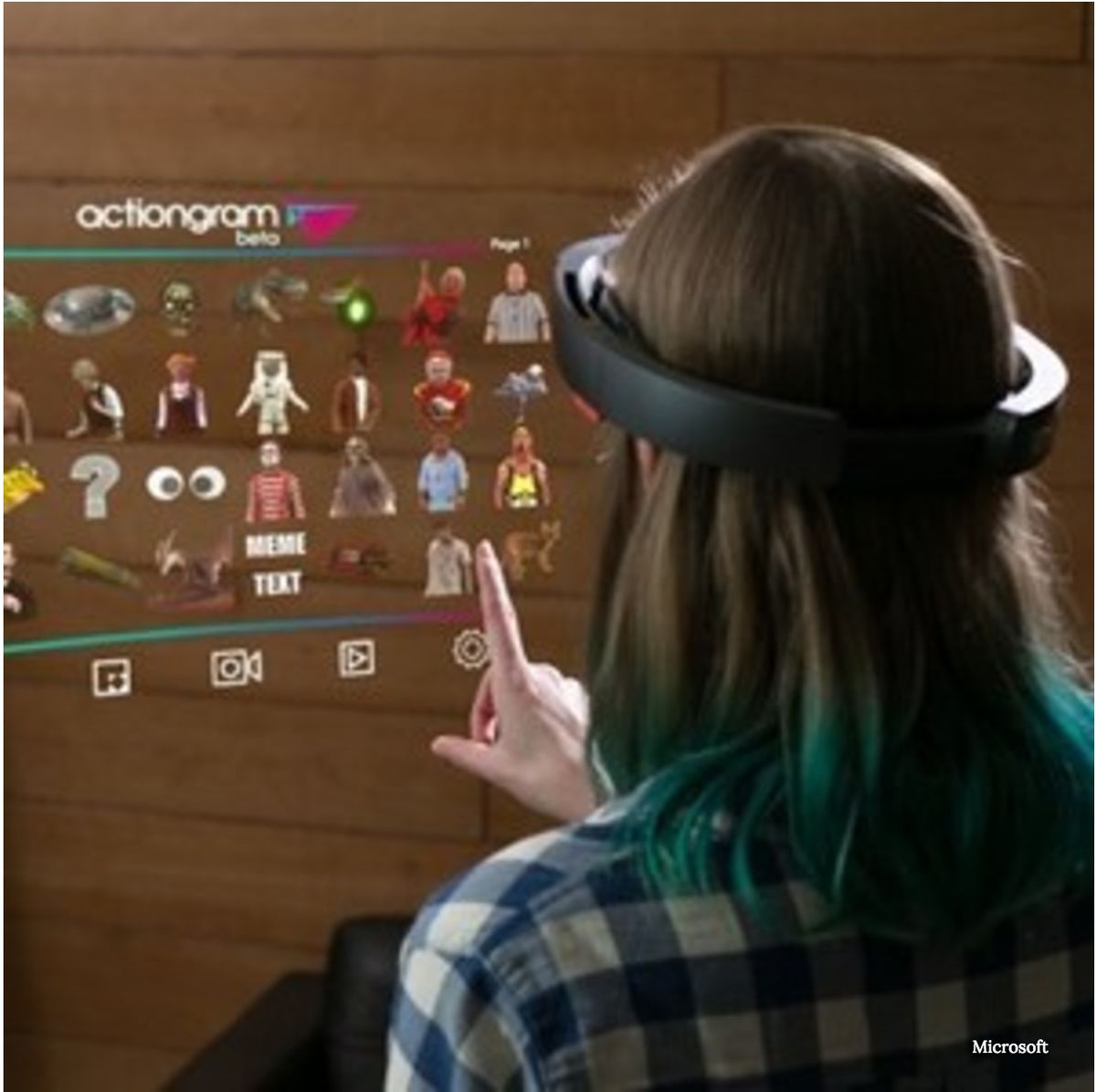
Augmented reality, or AR, is technology that blends virtual content with real-world surroundings. Unlike virtual reality, which immerses you in a self-contained digital world, AR overlays 3D graphics and interactive characters into your everyday world.
In the hit game Pokémon Go, players use their smartphones to catch Pokémon characters in the local park or at the office. Released in July 2016, the game was downloaded faster than any mobile app in history and generated nearly $1 billion in revenue in its first six months.
Yet despite Pokémon Go's huge numbers, when surveyors asked average Americans what they thought about augmented reality, the majority of people didn't have a clue. In a ReportLinker survey conducted last September — the same month that Pokémon Go downloads topped 500 million — 58 percent of Americans said they were "not at all familiar with" augmented reality. Awareness was slightly higher among famously connected millennials.
The survey results highlight AR's frustrating identity crisis.
While Silicon Valley investors and tech CEOs are hyping AR as a game-changing technology that's going to transform the way we interact with computers and our world, the average consumer still needs a lot of convincing. Where is the killer new device or app that's going to make augmented reality a reality?
RELATED: Coloring Books Go 3D with Augmented Reality
Shawn Cheng has been closely tracking the augmented reality and virtual reality space as a venture capitalist with Vayner/RSE. He sees huge long-term potential for AR technology to make a real impact in gaming, entertainment and education. But in the short-term, he recognizes that augmented reality is in a tough spot in the hype cycle where its high expectations aren't backed up by real-world applications.
Sign up for the Live Science daily newsletter now
Get the world’s most fascinating discoveries delivered straight to your inbox.
Cheng points to Magic Leap, a Florida company developing an AR headset that is rumored to deliver mind-blowing interactive graphics for entertainment and productivity. Bigshots like Google and Warner Bros. have invested more than a billion dollars in the headset. But we've yet to see even a prototype.
"I don't know if Magic Leap will ever be able to pay off on the hype that's surrounding them," Cheng told Seeker. "The proof will be people voting with their dollars. For all the promise and excitement that investors have a for a particular space, it's still going to come down to whether or not their narrative, what they say that they can do, is something people are willing to pay for."
The problem right now is that consumers don't have many real AR options from which to choose. Microsoft's HoloLens, one of the first true AR headsets, retails for $3,000. It's undeniably cool, but the list of available applications is still awfully short for that kind of investment. Plus the bulky headset, which looks like a futuristic welding visor, is not exactly something that you're going to wear around town.
Blair MacIntyre has been researching and developing AR technology and applications since 1991. He's currently on leave from Georgia Tech's School of Interactive Computing to help develop an AR browser for Mozilla. MacIntyre thinks that we're still a few years away from compelling consumer AR products with mass appeal.
RELATED: Augmented-Reality Diving Helmets Join the US Navy
"We're still at the point when the underlying technologies aren't really great for delivering the kinds of experiences that people imagine," said MacIntyre. "'I'll put on a pair of glasses, I'll walk down the street and I'll see stuff all around me: social media, advertising, games, things related to my job.' And we're a long way from having a head-mounted display that 99 percent of the public would be comfortable wearing around outside for a whole day."
Call that the Google Glass conundrum. When Google released a beta version of its now-infamous AR headset in 2013, it was widely criticized for its geeky looks, which only seemed to amplify the creepy factor of its built-in video camera. Glass was discontinued in 2015, but other headset makers are learning from Google's very public missteps.
Paul Travers is the CEO of Vuzix, a company that cut its teeth making AR headsets for industrial, commercial and military applications, most of which are as unsexy as an Excel spreadsheet. But Vuzix debuted a new pair of lightweight AR sunglasses at CES 2017 that Travers hopes will change the American consumer's tune on AR specs.
"If you're going to play at consumers, you can't look dumb," Travers told Seeker in an interview. "When you put on any of the headsets that work in business, you still look like you stepped off the starship enterprise. Consumers won't wear them."
A pair of Vuzix Blade 3000 sunglasses, which will sell for $500 later in 2017, weigh in at only 2.8 ounces while packing impressive processing power and a heads-up 3D graphics display. Travers heralds the widespread adoption of hands-free AR headsets a "paradigm shift."
"The ability to connect the web to the real world opens up so many amazing possibilities," Travers said. "One application could drive this thing through the roof if it was right."
But what will be that killer AR app? Pokémon Go points the way, but even that wasn't a pure AR game. Cheng at Vayner/RSE says many Pokémon Go players shut off the AR component, which wasn't integral to game play. He credits the game's success to great intellectual property — the Pokémon brand itself — not to its magical merging of virtual and real.
Until everybody is walking around with AR glasses, the platform with the biggest potential for AR adoption is the smartphone. But the problem, said MacIntyre at Mozilla, is that Apple and Android have yet to release phones with real AR capabilities. The GPS-based spatial location on the iPhone isn't precise enough to accurately map the world around us.
"GPS is great for Google Maps, but if I want to hold my phone and look at a Pokémon that's 20 feet away from me, and the GPS error is two to five meters, that's really not going to work," said MacIntyre. "The Pokemon is going to be jumping dramatically from left to right as my phone's estimate of where I am is jumping around."
RELATED: Futuristic Helmets Use Smart Glasses, Augmented Reality
Google's new Tango-enabled phones are equipped with special depth cameras that can scan a room or a street and build an inch-by-inch 3D map. With Tango technology — currently only available on a handful of Lenovo and Asus phones — a Pokémon Go character can hide behind a stone fountain and an interactive map of the solar system can stretch across your dining room table.
Gap, the retail clothing giant, recently launched a virtual dressing room app for Tango-enabled phones. Kendra Gratteri is chief customer officer at Avametric, an AR fashion start-up that built the Gap app, which allows shoppers to "try on" different garments using a 3D avatar in their phones. The Gap app allows for handy side-by-side fit comparisons and a 360-degree view, but Gratteri said that's just the tip of the iceberg.
"We're also working on using the Tango platform as a scanner," she said in an interview. "So you could scan your own body or have someone scan you and those measurements would drop into our system and create a personalize avatar."
Gratteri imagines a very near future where our fully-customized 3D avatar follows us through the shopping experience. Instead of sticking to the same few brands and clothing items we currently feel comfortable buying online, we could search the broader fashion world for garments that match the contours of our avatar.
Still, Gratteri admits, "Until Apple offers a solution for a depth sensor camera, we understand that wide use is going to be a little curtailed."
An AR-enabled iPhone or an Apple AR headset might be just the big break that AR desperately needs to enter the mainstream. And consumers may not have to wait much longer. Apple has been quietly buying up AR software and hardware companies for years and a pair of recent patents have lead some to predict the release of an Apple-branded AR device as early as late 2017.
Top photo: Microsoft's HoloLens version of Snapchat and Vine: Actiongram. Credit: Microsoft
WATCH: Are We Ready for Virtual Reality?
Originally published on Seeker.
Most Popular




